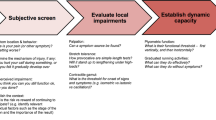Summary
Every year physicians all over the world are asked to perform preparticipation physical evaluations (PPE) for children involved in sports. The PPE should be brief yet comprehensive enough to determine which athletes are at risk. In addition, the examination may help determine the athlete’s general health and maturity level, uncover any disqualifying conditions and may also help establish a doctor-patient relationship. PPEs should be performed 4 to 6 weeks prior to initiation of the sport and be repeated every 1 to 3 years. A station-based exam may help evaluate large numbers of athletes within a limited time period.
The history is the most important aspect of the PPE and should focus on prior cardiovascular complications, a family history of cardiovascular death before 50 years of age and any other limiting medical problems. A general physical examination should be performed to focus on areas involved in sports participation. Laboratory tests are not usually necessary. Disqualifying conditions may be determined based on the physical abnormality present and the amount of contact or energy involved in the sport to be played.
Throughout the world, sports participation is growing rapidly. Although these guidelines have been drafted by a consortium of sports-related and general practice groups in the US, they can easily be applied worldwide. Unfortunately the health of young adults in developing countries may not be as good as that of those residing in more industrialised countries, therefore each athlete must be considered individually. With this type of individualised approach the examining physician can make informed and intelligent decisions concerning the athlete’s participation.
Similar content being viewed by others
References
Tanji JL. The preparticipation physical examination for sports. Am Fam Physician 1990 42(2): 397–402
Shaffer TE. The health examination for participation in sports. Pediatricians Annual 1978; 7: 666–75
Smilkstein G. Health evaluation of high school athletes. Physician Sports Med 1981; 9(8): 73–6, 79-81
Feinstein RA, Soileau EJ, Daniel WA Jr. A National survey of preparticipation physical examination requirements. Physician Sports Med 1988; 16(5): 51–9
Ball RM. The sports preparticipation evaluation. N J Med 1991; 88(9): 629–33
Department of Health and Human Services. The national children and youth fitness study. J Phys Educ Recreat Dance 1985; 1(6): 44–90
McKeag DB. Preseason physical examination for the prevention of sports injuries. Sports Med 1985; 2(6): 413–31
Magnes SA, Henderson JM, Hunter SC. What conditions limit sports participation? Experience with 10,540 Athletes. Physician Sports Med 1992: 20(5): 143–60
Dyment PG. The othopedic component of the preparticipation examination. Pediatr Ann 1992 21(3): 157–62
Tanner SM. Preparticipation examination targeted for the female athlete. Clin Sports Med 1994 Apr; 13(2): 337–53
Risser WL, Hoffman HM, Bellah GG Jr. Frequency of preparticipation sports examinations in secondary school athletes: are the university interscholastic league guidelines appropriate? Tex Med 1985: 81(7) 35–9
Van Camp SR Sudden death in athletes. In: Grana WA, Lombardo JA, editors. Advances in sports medicine and fitness. Chicago: Year Book Medical Publishers, 1988: 121–42
American Academy of Family Physicians, American Academy of Pediatrics, American medical Society for Sports Medicine, et al. Preparticipation Physical Evaluation. Kansas City (MO): American Academy of Family Physicians, 1992
Bratton RL, Agerter DC. Preparticipation sports examinations. Postgrad Med 1995 Aug; 98(2): 123–32
Mitchell JH, Maron BJ, Epstein SE. 16th Bethesda Conference. Cardiovascular abnormalities in the athlete: recommendations regarding eligibility for competition. J Am Coll Cardiol 1985; 6(6): 1186–232
Johnson RJ. HIV infection in athletes: what are the risks? Who can compete? Postgrad Med 1992: 92(7) 73–80
American Academy of Pediatrics Committee on Sports Medicine and Fitness. Human immunodeficiency virus [acquired immunodeficiency syndrome (AIDS) virus] in the athletic setting. Pediatrics 1991; 88(3): 640–1
Wormser GP, Bittker S, Forseter G, et al. Absence of human immunodeficiency virus type 1 in natural eccrine sweat. J Infect Dis 1992; 165(1): 155–8
Author information
Authors and Affiliations
Rights and permissions
About this article
Cite this article
Bratton, R.L. Preparticipation Screening of Children for Sports. Sports Med 24, 300–307 (1997). https://doi.org/10.2165/00007256-199724050-00002
Published:
Issue Date:
DOI: https://doi.org/10.2165/00007256-199724050-00002




